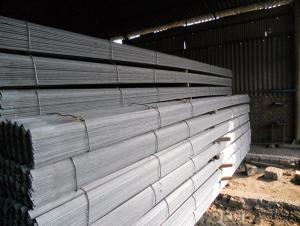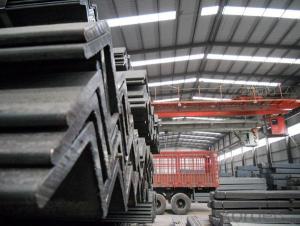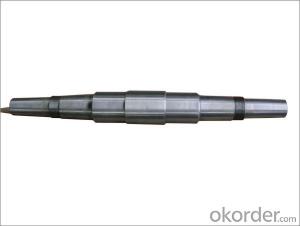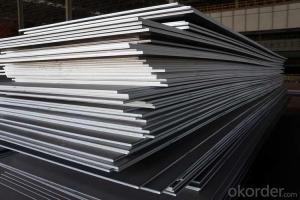High Quality Hot Rolled Equal Angle Steel Bars for Constrcution
- Loading Port:
- Tianjin
- Payment Terms:
- TT OR LC
- Min Order Qty:
- 25 m.t.
- Supply Capability:
- 200000 m.t./month
OKorder Service Pledge
OKorder Financial Service
You Might Also Like
Product Description:
OKorder is offering high quality High Quality Hot Rolled Equal Angle Steel Bars for Constrcution at great prices with worldwide shipping. Our supplier is a world-class manufacturer of steel, with our products utilized the world over. OKorder annually supplies products to European, North American and Asian markets. We provide quotations within 24 hours of receiving an inquiry and guarantee competitive prices.
Product Applications:
High Quality Hot Rolled Equal Angle Steel Bars for Constrcution are ideal for structural applications and are widely used in the construction of buildings and bridges, and the manufacturing, petrochemical, and transportation industries.
1. Supporting members, most commonly in the house raising industry to strengthen timber bears under houses. Transmission line towers, etc
2. Prefabricated structure
3. Medium scale bridges
4. It is widely used in various building structures and engineering structures such as roof beams, bridges, transmission towers, hoisting machinery and transport machinery, ships, industrial furnaces, reaction tower, container frame and warehouse etc.
Product Advantages:
High Quality Hot Rolled Equal Angle Steel Bars for Constrcution are durable, strong, and resist corrosion.
Main Product Features:
· Premium quality
· Prompt delivery & seaworthy packing (30 days after receiving deposit)
· Corrosion resistance
· Can be recycled and reused
· Mill test certification
· Professional Service
· Competitive pricing
Product Specifications:
1. Invoicing on theoretical weight or actual weight as customer request
2. Standard: EN10025, GB Standard, ASTM
3. Grade: Q235B, Q345B, SS400, ASTM A36, S235JR, S275JR
4.Sizes:
EQUAL ANGLES SIZES | |||
a(mm) | a1(mm) | thickness(mm) | length |
25 | 25 | 2.5---3.0 | 6M/12M |
30 | 30 | 2.5---4.0 | 6M/12M |
38 | 38 | 2.5 | 6M/12M |
38 | 38 | 3.0---5.0 | 6M/12M |
40 | 40 | 3.0---6.0 | 6M/12M |
50 | 50 | 3 | 6M/12M |
50 | 50 | 3.7---6.0 | 6M/9M/12M |
60 | 60 | 5.0---6.0 | 6M/9M/12M |
63 | 63 | 6.0---8.0 | 6M/9M/12M |
65 | 65 | 5.0---8.0 | 6M/9M/12M |
70 | 70 | 6.0---7.0 | 6M/9M/12M |
75 | 75 | 5.0---10.0 | 6M/9M/12M |
80 | 80 | 6.0---10.0 | 6M/9M/12M |
90 | 90 | 6.0---10.0 | 6M/9M/12M |
100 | 100 | 6.0---12.0 | 6M/9M/12M |
120 | 120 | 8.0-12.0 | 6M/9M/12M |
125 | 125 | 8.0---12.0 | 6M/9M/12M |
130 | 130 | 9.0-12.0 | 6M/9M/12M |
140 | 140 | 10.0-16.0 | 6M/9M/12M |
150 | 150 | 10---15 | 6M/9M/12M |
160 | 160 | 10---16 | 6M/9M/12M |
180 | 180 | 12---18 | 6M/9M/12M |
200 | 200 | 14---20 | 6M/9M/12M |
5. Material details:
Alloy No | Grade | Element (%) | |||||
C | Mn | S | P | Si | |||
Q235 | B | 0.12—0.20 | 0.3—0.7 | ≤0.045 | ≤0.045 | ≤0.3 | |
Alloy No | Grade | Yielding strength point( Mpa) | |||||
Thickness (mm) | |||||||
≤16 | >16--40 | >40--60 | >60--100 | ||||
≥ | |||||||
Q235 | B | 235 | 225 | 215 | 205 | ||
Alloy No | Grade | Tensile strength (Mpa) | Elongation after fracture (%) | ||||
Thickness (mm) | |||||||
≤16 | >16--40 | >40--60 | >60--100 | ||||
≥ | |||||||
Q235 | B | 375--500 | 26 | 25 | 24 | 23 | |
FAQ:
Q1: Why buy Materials & Equipment from OKorder.com?
A1: All products offered byOKorder.com are carefully selected from China's most reliable manufacturing enterprises. Through its ISO certifications, OKorder.com adheres to the highest standards and a commitment to supply chain safety and customer satisfaction.
Q2: How do we guarantee the quality of our products?
A2: We have established an advanced quality management system which conducts strict quality tests at every step, from raw materials to the final product. At the same time, we provide extensive follow-up service assurances as required.
Q3: How soon can we receive the product after purchase?
A3: Within three days of placing an order, we will begin production. The specific shipping date is dependent upon international and government factors, but is typically 7 to 10 workdays.
Q4: What makes stainless steel stainless?
A4: Stainless steel must contain at least 10.5 % chromium. It is this element that reacts with the oxygen in the air to form a complex chrome-oxide surface layer that is invisible but strong enough to prevent further oxygen from "staining" (rusting) the surface. Higher levels of chromium and the addition of other alloying elements such as nickel and molybdenum enhance this surface layer and improve the corrosion resistance of the stainless material.
Q5: Can stainless steel rust?
A5: Stainless does not "rust" as you think of regular steel rusting with a red oxide on the surface that flakes off. If you see red rust it is probably due to some iron particles that have contaminated the surface of the stainless steel and it is these iron particles that are rusting. Look at the source of the rusting and see if you can remove it from the surface.
Images:


- Q: What are the typical lengths of steel I-beams?
- The typical lengths of steel I-beams can vary depending on the specific application and industry standards. However, common lengths range from 20 feet to 60 feet or more.
- Q: What are the considerations for steel I-beam design in extreme temperatures?
- When designing steel I-beams for extreme temperatures, there are several important considerations to take into account. Firstly, it is crucial to understand the effect of temperature on the mechanical properties of the steel. Steel's strength and stiffness decrease as the temperature increases, and this reduction can be significant at extremely high or low temperatures. Therefore, the design needs to account for these changes in material behavior to ensure the structural integrity and safety of the I-beam. Another consideration is thermal expansion and contraction. Steel expands when heated and contracts when cooled, and this thermal movement can introduce stresses and potential deformations in the I-beam. To mitigate these effects, appropriate expansion joints or allowances must be incorporated into the design to allow for thermal movement without compromising the overall stability of the structure. In extreme cold temperatures, steel becomes more brittle, which increases the risk of fracture. Therefore, the design should include measures to prevent brittle fracture, such as using steel grades with good low-temperature toughness or incorporating additional reinforcement to enhance the beam's resistance to cracking. Additionally, extreme temperatures can also affect the corrosion resistance of steel. In high-temperature environments, steel may be exposed to aggressive chemical reactions that can accelerate corrosion. Therefore, suitable protective coatings or materials should be applied to prevent corrosion and extend the service life of the I-beam. Furthermore, it is important to consider the effects of temperature on the surrounding environment. For example, if the steel I-beam is exposed to extreme heat, such as in a fire, it may need to be designed to withstand elevated temperatures for a specific duration to ensure structural stability and prevent collapse. Overall, designing steel I-beams for extreme temperatures requires a thorough understanding of material properties, thermal expansion, potential for brittle fracture, corrosion resistance, and the surrounding environment. By carefully considering these factors, engineers can develop robust and safe designs that can withstand extreme temperature conditions.
- Q: Can steel I-beams be used in seismic retrofitting or strengthening projects?
- Yes, steel I-beams can be used in seismic retrofitting or strengthening projects. Steel I-beams are often preferred in seismic retrofitting due to their high strength and ductility. They can be used to reinforce existing structures by adding additional support and stiffness to the building. Steel I-beams are commonly used to strengthen walls, columns, and floors, which helps to improve the building's ability to withstand seismic forces. Additionally, steel I-beams can be installed in a variety of configurations, such as adding them as braces or installing them as a moment frame system, depending on the specific needs of the retrofitting project. Overall, steel I-beams are a versatile and effective solution for seismic retrofitting and strengthening projects.
- Q: Can steel I-beams be custom fabricated?
- Yes, steel I-beams can be custom fabricated to meet specific design and structural requirements.
- Q: How do steel I-beams contribute to sustainability in construction?
- Steel I-beams contribute to sustainability in construction in several ways. Firstly, steel is a highly durable material with a long lifespan, meaning that structures built with steel I-beams have a reduced need for maintenance and replacement over time. This reduces waste and the consumption of resources. Additionally, steel is a recyclable material, allowing for the reuse and repurposing of I-beams at the end of their lifecycle. This reduces the demand for new steel production and helps to conserve natural resources. Moreover, steel I-beams are lightweight yet strong, allowing for efficient construction processes and the use of fewer materials overall. Lastly, steel is resistant to fire, pests, and weathering, which enhances the longevity and resilience of structures, further supporting sustainability in construction.
- Q: How do steel I-beams perform in terms of energy efficiency?
- Steel I-beams are known for their strength and durability, but when it comes to energy efficiency, they may not be the most ideal choice. Steel is a good conductor of heat, which means that it can easily transfer heat from the inside to the outside of a building or vice versa. This can result in significant energy loss when it comes to heating or cooling a space. Additionally, steel production is energy-intensive, requiring large amounts of energy to extract and refine iron ore and coal to produce steel. This process contributes to greenhouse gas emissions and is not considered environmentally friendly. However, it is important to note that energy efficiency is not solely determined by the choice of I-beams, but rather the overall design and construction of a building. Proper insulation, efficient HVAC systems, and energy-efficient windows can help mitigate the impact of steel I-beams on energy efficiency. Furthermore, steel I-beams offer advantages in terms of structural integrity and design flexibility, allowing for larger open spaces and longer spans. These benefits can lead to more efficient use of materials and potentially reduced construction costs. In conclusion, while steel I-beams may not be the most energy-efficient choice, their overall impact on a building's energy efficiency can be mitigated through other design and construction measures. It is important to consider the entire building envelope and energy systems when evaluating the energy efficiency of a structure.
- Q: Can steel I-beams be used for highway sign supports?
- Yes, steel I-beams can be used for highway sign supports. Steel I-beams are commonly used in construction for their strength and durability, making them suitable for supporting highway signs, which require stability and resilience in outdoor environments.
- Q: Are steel I-beams suitable for supporting rooftop greenhouses?
- Yes, steel I-beams are suitable for supporting rooftop greenhouses. They offer excellent strength and durability, making them a reliable choice for providing structural support. Additionally, steel I-beams can withstand heavy loads and are resistant to environmental factors such as wind and snow, making them an ideal option for rooftop greenhouse installations.
- Q: Are there any special considerations when designing with steel I-beams for multi-story buildings?
- Designing multi-story buildings with steel I-beams involves several important factors to consider. 1. Load-bearing capacity: Steel I-beams are chosen for their ability to bear heavy loads. The structural engineer must carefully calculate the loads that the beams will carry, including dead loads (building weight), live loads (occupants, furniture, equipment), and additional loads like snow or wind. 2. Span length: The length of the beams is crucial in designing multi-story buildings. Longer spans require larger and heavier beams to adequately support the loads. Therefore, the engineer must consider the maximum span length that the steel I-beams can safely handle without excessive deflection or stress. 3. Fire resistance: Although steel is fire-resistant, it can lose strength at high temperatures. In multi-story buildings, fire protection measures such as fireproof coatings or fire-resistant materials may need to be applied to steel beams to maintain their structural integrity during a fire. 4. Connection design: Proper connection design is vital when using steel I-beams in multi-story buildings. The connections between beams and columns must be strong and rigid for efficient load transfer. Welding, bolting, or a combination of both can be used, and the engineer must carefully design and detail these connections to resist the expected loads. 5. Building movement: Multi-story buildings experience various movements, like thermal expansion, wind-induced vibrations, and seismic activity. The design of steel I-beams should account for these movements to ensure they can withstand them without compromising the building's structural integrity. 6. Construction process: Constructing multi-story buildings with steel I-beams requires meticulous planning and coordination. The beams are typically fabricated off-site and then transported to the construction site for installation. The design should consider the size, weight, and transportability of the beams to ensure safe delivery and erection. In conclusion, designing with steel I-beams for multi-story buildings necessitates a comprehensive understanding of structural engineering principles, load calculations, fire protection, connection design, building movements, and construction processes. By considering these factors, engineers can ensure the safe and efficient use of steel I-beams in multi-story building designs.
- Q: What are the load-bearing capacity of rectangular and I-beam steel sections of the same size?
- Therefore, if the stability is not considered, the bearing capacity of I-beam is large.But the stability of the rectangular steel is better, it is not easy to lose stability.
Send your message to us
High Quality Hot Rolled Equal Angle Steel Bars for Constrcution
- Loading Port:
- Tianjin
- Payment Terms:
- TT OR LC
- Min Order Qty:
- 25 m.t.
- Supply Capability:
- 200000 m.t./month
OKorder Service Pledge
OKorder Financial Service
Similar products
Hot products
Hot Searches
Related keywords



























